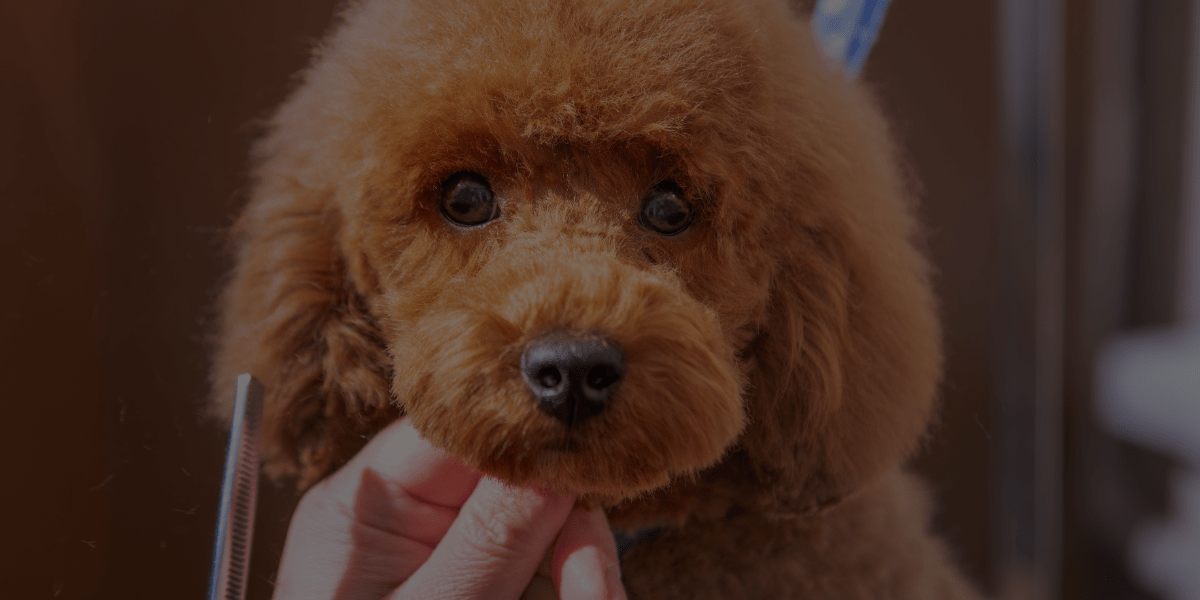Thinking of enrolling in QC Pet Studies’ online Dog Grooming Course? Camille Torkornoo, a current student, is here to break down what’s taught in Unit A! Camille’s business, Mount Zion Kennels, specializes in grooming and breeding standard Poodles. Learn more about Camille by reading her Student Feature!
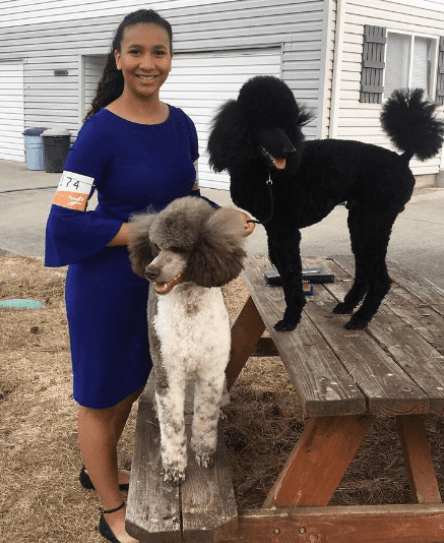
I learned a lot of important information from Unit A of my Dog Grooming Course. One of my favorite features included in this program is the feedback I get from my tutor, Lisa Day. I find it very helpful in my learning because a real industry expert is helping me see what I’ve done well, as well as what I can improve upon.
Unit A thoroughly covers what it means to be a dog groomer. You learn about canine anatomy and terminology, along with canine skincare and esthetics. QC also makes sure to teach you the risks that come with the profession and which precautions can be taken to prevent injuries. All of this information is essential!
The Most Important Lesson I Learned in Unit A Was…
…the Personal Health and Safety section! Dog grooming is a physically demanding job. As such, it has the potential to be dangerous as well. By taking the advised precautions outlined in Unit A, dog groomers can create a safer working environment. In turn, this will help reduce the risk of serious injuries.
Common Dog Grooming Risks
Naturally, some of the risks involved with grooming include bites and scratches. This is to be expected with any job involving animals. But dog groomers also risk developing long-term health issues, too.
For instance, groomers must constantly lift dogs and use loud equipment. These things, when combined with the constant repetitive motions involved when grooming dogs, can lead to physical bodily damage.
Groomers also need to watch out for carpal tunnel syndrome, back injuries, joint damage, and even hearing loss. The constant inhalation of dander, hair, chemicals, and bacteria can lead to respiratory damage. The consequences of this can range from a chronic cough, to chronic obstructive pulmonary disease. In the world of dog grooming, general respiratory damage developed on the job is known as “Groomer’s Lung.”
This is why it’s extremely important to take a proper dog grooming course. Professional training will make you aware of these potential risks and teach you how to avoid them (to the best of your ability).
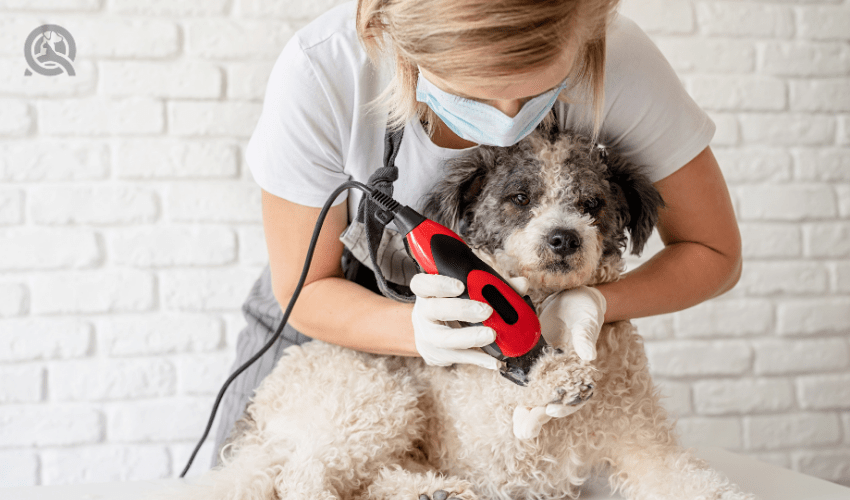
Preventative Measures Taught in Unit A of QC’s Dog Grooming Course
Unit A provides the following tips to help prevent and/or lower the risk of contracting the above issues…
Preventing Hearing Loss / Damage
Groomers can wear earplugs or noise cancelling/reducing headphones. These will help prevent hearing loss or damage caused by the constant use of loud dryers.
Preventing Harmful Inhalation
Wearing a mask can help protect against the inhalation of dog hair, dander, ground nails, etc. As a result, masks can help lower the risk of contracting could “Groomer’s Lung.”
Preventing Eye Injuries
Using a form of eye protection can also be a wise precaution. It will help prevent debris from flying up into your eyes when clipping a dog, drying them, or grinding their nails.
Preventing Muscle / Joint Damage
Braces can be a smart investment for a dog groomer. For example, wrist braces and exercises can help reduce the risk of excess wrist strain caused by constant, repetitive clipping, brushing, de-matting, and scissoring on dogs. Back braces and exercises are also useful, too. As groomers, we constantly need to lift and bend while working with dogs. The last thing you want to do is blow out your back!
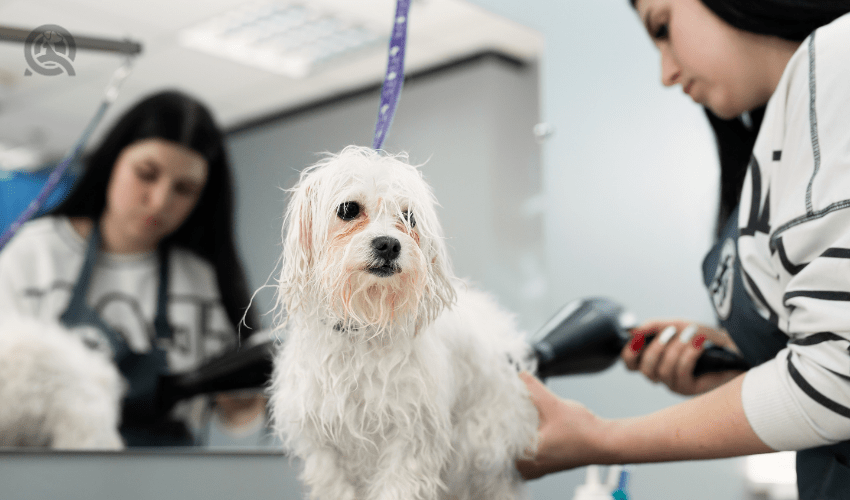
Other Health and Safety Tips
Unit A of QC’s Dog Grooming Course also covers specific exercises for groomers to do. When done correctly and regularly, these exercises can aid in avoiding or decreasing muscle strain, pain, and injury.
The assignments in Unit A of my dog grooming course also added to my training. Specifically, they helped me gain a better understanding of ways to create a safe environment in different circumstances. The assignments gave hypothetical situations for me to navigate. I needed to provide a way to prevent injury and maintain safety in the proposed situations. It was a great learning experience!
Canine Anatomy
Canine anatomy is another critical topic your dog grooming course absolutely needs to teach you. In QC’s program, this is covered in Unit A. I found this particular lesson to be very important. The assignments helped me to become more familiar with the different parts of a dog. I also learned all about various types of conformation and physical attributes, coat types, coat features, and more!
Knowing canine anatomy and breed variations will take a groomer’s skill-set from good to great. This is because you’ll then understand how to properly create a look that highlights a dog’s breed-specific features. As a result, you’ll be capable of creating the breed’s profile look.
QC’s Dog Grooming Course will teach you how to create a balanced look on different types of dogs, as well as properly work on dogs with structural faults and/or physical restrictions.
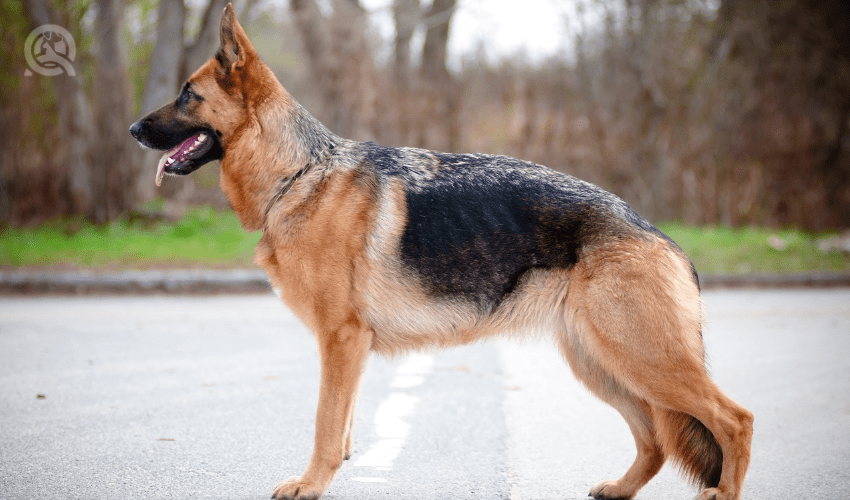
Skincare and Esthetics
In the Skincare and Esthetics portion of Unit A, I was taught about the anatomy of a dog’s hair and skin. I also learned about the different layers and cells, and their purposes. Proper skincare is important! As a groomer, you need to know how to maintain a healthy coat and the dog’s skin in general.
By taking a dog grooming course, you’ll discover the most common skin issues and conditions in dogs – from fleas to mange. I was grateful to learn about this in Unit A of QC’s program. As a groomer, the dog’s wellbeing always has to be your very first priority.
You must understand how a dog’s skin and coat work, as well as how to maintain it. That way, your clients’ dogs will leave in top condition and look great!
Dog Groomer vs. Veterinarian
All that being said, it’s crucial to remember that you’re a groomer. You’re not a veterinarian. As such, it’s important to stay in your lane. Never try to provide owners with a diagnosis, even if you think you know what the problem is.
Yes, as a groomer, you’ll deal with a dog’s coat and skin more than their vet will. But vets have extensive medical training – the kind of training you won’t find in any dog grooming course. If you do suspect that your client’s dog has some sort of medical issue, raise your concerns with the owner and recommend that they seek out their veterinarian’s professional opinion.
Sometimes, it’ll be the client who unknowingly blurs the line between your job description and a vet’s. They might ask you to do or recommend something that falls outside of your qualifications. This is why it’s important to always be clear that you are not a vet and can’t provide a diagnosis. All you can do is raise your concerns with them. After that, it’s the client’s responsibility to seek further medical advice from a trained expert.
If a dog comes into your shop with a suspected condition that could be potentially contagious, Unit A will provide you the knowledge to deal with it safely and accordingly.
Want to learn more about distinguishing your role as a groomer from that of a vet? Keep reading here!
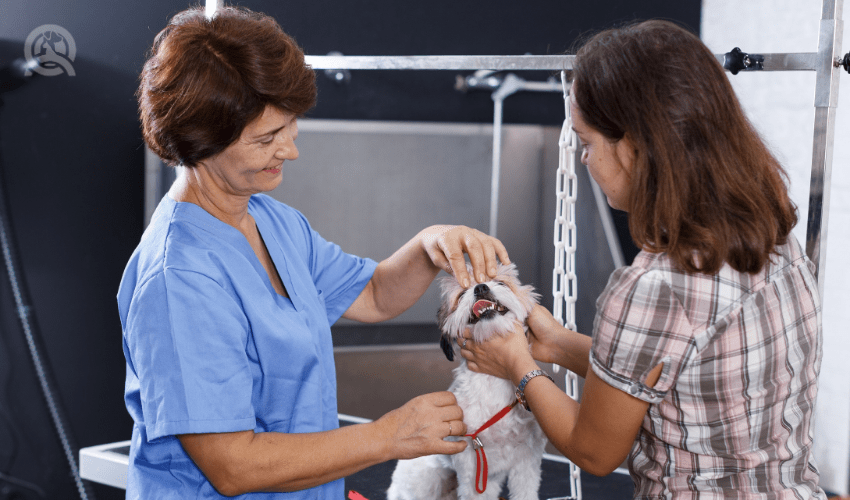
Overall, I learned a LOT of invaluable information from Unit A of QC’s Dog Grooming Course. If your dream job is to work with dogs every day, perhaps grooming is the perfect career path for you. And if it is, there’s no grooming school I recommend more than QC Pet Studies.
